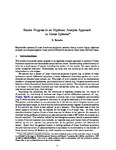Recent progress in an algebraic analysis approach to linear systems
| dc.contributor.author | Robertz, D | |
| dc.date.accessioned | 2017-03-25T11:43:12Z | |
| dc.date.available | 2017-03-25T11:43:12Z | |
| dc.date.issued | 2015-04 | |
| dc.identifier.issn | 0923-6082 | |
| dc.identifier.issn | 1573-0824 | |
| dc.identifier.uri | http://hdl.handle.net/10026.1/8691 | |
| dc.description.abstract |
This paper addresses systems of linear functional equations from an algebraic point of view. We give an introduction to and an overview of recent work by a small group of people including the author of this article on effective methods which determine structural properties of such systems. We focus on parametrizability of the behavior, i.e., the set of solutions in an appropriate signal space, which is equivalent to controllability in many control-theoretic situations. Flatness of the linear system corresponds to the existence of an injective parametrization. Using an algebraic analysis approach, we associate with a linear system a module over a ring of operators. For systems of linear partial differential equations we choose a ring of differential operators, for multidimensional discrete linear systems a ring of shift operators, for linear differential time-delay systems a combination of those, etc. Rings of these kinds are Ore algebras, which admit Janet basis or Gröbner basis computations. Module theory and homological algebra can then be applied effectively to study a linear system via its system module, the interpretation depending on the duality between equations and solutions. In particular, the problem of computing bases of finitely generated free modules (i.e., of computing flat outputs for linear systems) is addressed for different kinds of algebras of operators, e.g., the Weyl algebras. Some work on computer algebra packages, which have been developed in this context, is summarized. | |
| dc.format.extent | 349-388 | |
| dc.language | en | |
| dc.language.iso | en | |
| dc.publisher | Springer Science and Business Media LLC | |
| dc.subject | Systems of linear functional equations | |
| dc.subject | Systems theory | |
| dc.subject | Control theory | |
| dc.subject | Algebraic analysis | |
| dc.subject | Homological algebra | |
| dc.subject | Linear partial differential equations | |
| dc.subject | Janet bases | |
| dc.subject | Grobner bases | |
| dc.title | Recent progress in an algebraic analysis approach to linear systems | |
| dc.type | journal-article | |
| dc.type | Article | |
| plymouth.author-url | https://www.webofscience.com/api/gateway?GWVersion=2&SrcApp=PARTNER_APP&SrcAuth=LinksAMR&KeyUT=WOS:000350570900003&DestLinkType=FullRecord&DestApp=ALL_WOS&UsrCustomerID=11bb513d99f797142bcfeffcc58ea008 | |
| plymouth.issue | 2 | |
| plymouth.volume | 26 | |
| plymouth.publication-status | Published | |
| plymouth.journal | Multidimensional Systems and Signal Processing | |
| dc.identifier.doi | 10.1007/s11045-014-0280-9 | |
| plymouth.organisational-group | /Plymouth | |
| plymouth.organisational-group | /Plymouth/Faculty of Science and Engineering | |
| plymouth.organisational-group | /Plymouth/Faculty of Science and Engineering/School of Engineering, Computing and Mathematics | |
| plymouth.organisational-group | /Plymouth/Users by role | |
| plymouth.organisational-group | /Plymouth/Users by role/Academics | |
| dc.identifier.eissn | 1573-0824 | |
| dc.rights.embargoperiod | Not known | |
| rioxxterms.versionofrecord | 10.1007/s11045-014-0280-9 | |
| rioxxterms.licenseref.uri | http://www.rioxx.net/licenses/all-rights-reserved | |
| rioxxterms.type | Journal Article/Review |


